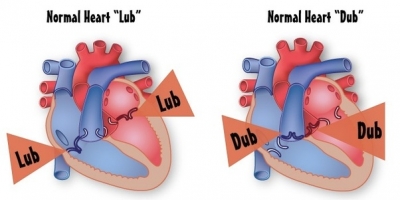
Heart sounds are generated by the turbulance created by blood flowing through the heart, specifically when the heart valves close. Normal heart sounds can be characterized by a “lub” “dub” that occurs with a heart beat. The first heart sound (lub) occurs when the atrioventricular (AV) valves close and the second heart sound (dub) is heard when the semilunar valves close. Heart conditions can be identified by variation in these heart sounds, such as a murmur.
The first heart sound, called S1, makes a “lub” sound caused by the closure of the mitral and tricuspid valves as ventricular systole begins. There is a very slight split between the closure of the mitral and tricuspid valves, but it is not long enough to create multiple sounds.
The second heart sound, called S2, makes a “dub” sound caused by the closure of the semilunar (aortic and pulmonary) valves following ventricular systole. S2 is split because aortic valve closure occurs before pulmonary valve closure. During inspiration (breathing in) there is slightly increased blood return to the right side of the heart, which causes the pulmonary valve to stay open slightly longer than the aortic valve. Due to this, the naming convention is to divide the second sound into two second sounds, A2 (aortic), and P2 (pulmonary). The time between A2 and P2 is variable depending on the respiratory rate, but the split is generally only prominent in children during inspiration. In adults and during expiration, the split is usually not long enough to suggest two sounds.
Picture Credit : Google




